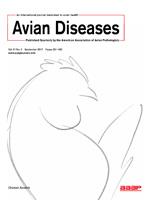Eggs contaminated with Salmonella Enteritidis are leading sources of human salmonellosis, but Salmonella Heidelberg and Salmonella Typhimurium are also egg-associated pathogens. The management practices and housing facilities characterizing different systems for housing commercial egg flocks can influence Salmonella persistence and transmission. Animal welfare aspects of poultry housing have been widely debated, but their food safety ramifications are not thoroughly understood. The present study assessed the effects of two different bird stocking densities on the frequency and duration of fecal shedding of strains of Salmonella Heidelberg and Salmonella Typhimurium in groups of experimentally infected laying hens housed in colony cages enriched with perching and nesting areas. In separate trials, laying hens were distributed into two groups housed in enriched colony cages at stocking densities of 648 and 973 cm2/bird, and a third group was housed in conventional cages at 648 cm2/bird. All hens were orally inoculated with doses of 108 colony-forming units (CFU) of either Salmonella Heidelberg or Salmonella Typhimurium. At eight weekly postinoculation intervals, samples of voided feces were collected from beneath each cage and cultured to detect Salmonella. Fecal shedding of Salmonella Heidelberg continued for 8 wk in all housing groups, but Salmonella Typhimurium shedding ceased after as little as 5 wk in enriched colony cages at low stocking density. After Salmonella Heidelberg infection, the overall frequency of positive fecal cultures for all sampling dates combined was significantly (P < 0.05) greater from either conventional cages (51.0%) or enriched colony cages (46.5%) at high stocking density than from enriched colony cages at low stocking density (33.3%). No significant differences in Salmonella Typhimurium fecal isolation were identified between housing groups. These results demonstrate that stocking density can affect intestinal colonization and fecal shedding in laying hens for some (but not necessarily all) Salmonella serovars or strains.
How to translate text using browser tools
3 July 2017
Frequency and Duration of Fecal Shedding of Salmonella Serovars Heidelberg and Typhimurium by Experimentally Infected Laying Hens Housed in Enriched Colony Cages at Different Stocking Densities
Richard K. Gast,
Rupa Guraya,
Deana R. Jones,
Jean Guard,
Kenneth E. Anderson,
Darrin M. Karcher
ACCESS THE FULL ARTICLE

Avian Diseases
Vol. 61 • No. 3
September 2017
Vol. 61 • No. 3
September 2017
fecal shedding
housing
laying hens
Salmonella Heidelberg
Salmonella typhimurium
stocking density




